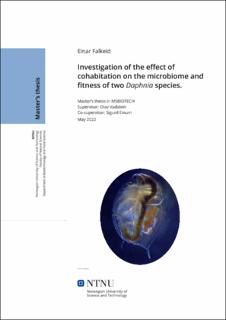| dc.contributor.advisor | Vadstein Olav | |
| dc.contributor.advisor | Einum Sigurd | |
| dc.contributor.author | Falkeid Einar | |
| dc.date.accessioned | 2022-07-09T17:20:27Z | |
| dc.date.available | 2022-07-09T17:20:27Z | |
| dc.date.issued | 2022 | |
| dc.identifier | no.ntnu:inspera:110630667:30190583 | |
| dc.identifier.uri | https://hdl.handle.net/11250/3004355 | |
| dc.description.abstract | Formålet med denne oppgaven var å undersøke effekten av kohabitering av Daphnia
magna og Daphnia pulex på mikrobiomet og levedyktigheten til de respektive artene.
Studien benytter labteknikker som ikke er anvendt på D. pulex tidligere. Dyrene ble
kultivert i kohabiterende og separate akvarier i tre uker. Etterpå ble mikrobiomet
deres overført til aposymbiotiske juveniler i seks behandlinger (3 for hver art,
endogent, cohabitat og fremmed mikrobiom). Fekunditet og kroppslengde ble m ̊alt.
Tarm og vannprøver ble tatt fra dyrene og deres akvarier. P å grunn av høy
dødelighet blandt D. pulex kan prøvene fra disse tre behandlingene ikke analyseres
statistisk.
Bakteriesammensetningen i prøvene ble analysert med 16s metagenomikk.
Signifikante differanser i bakteriesammensetningen ble funnet n ̊ar prøvene ble
gruppert etter behandling. Ingen signifikant differanse ble funnet n ̊ar prøvene ble
gruppert etter fekunditet. Behandling kunne ikke korreleres til fekunditet. | |
| dc.description.abstract | The purpose of this project was to investigate the effects of cohabitation of Daphnia
magna and Daphnia pulex on the microbiome and fitness of the respective species.
The study used laboratory techniques on D. pulex which have not been applied to
this species before. Specimens were cultured in shared and separate aquaria for three
weeks. Their microbiome was transferred to aposymbiotic juveniles in six treatment
groups (3 per species, endogenous, co-culture, and foreign microbiota). Fecundity and
body length was measured. Gut and water samples were taken from the animals and
their aquaria. Due to mortalities in the D. pulex cultures, the three treatments on D.
pulex did not yield enough data to analyze statistically.
The bacterial community in the samples was analysed with 16s metagenomics.
Significant differences in microbial community was detected based on treatment. No
significant difference in microbial community was found based on fecundity.
Treatment could not be correlated to changes in fecundity. | |
| dc.language | eng | |
| dc.publisher | NTNU | |
| dc.title | Investigation of the effect of cohabitation on the microbiome and fitness of two Daphnia species. | |
| dc.type | Master thesis | |
